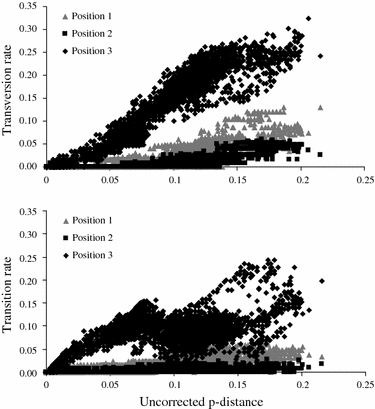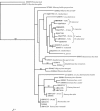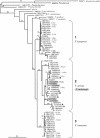Spider mite (Acari: Tetranychidae) mitochondrial COI phylogeny reviewed: host plant relationships, phylogeography, reproductive parasites and barcoding
- PMID: 17712605
- PMCID: PMC2039815
- DOI: 10.1007/s10493-007-9092-z
Spider mite (Acari: Tetranychidae) mitochondrial COI phylogeny reviewed: host plant relationships, phylogeography, reproductive parasites and barcoding
Abstract
The past 15 years have witnessed a number of molecular studies that aimed to resolve issues of species delineation and phylogeny of mites in the family Tetranychidae. The central part of the mitochondrial COI region has frequently been used for investigating intra- and interspecific variation. All these studies combined yield an extensive database of sequence information of the family Tetranychidae. We assembled this information in a single alignment and performed an overall phylogenetic analysis. The resulting phylogeny shows that important patterns have been overlooked in previous studies, whereas others disappear. It also reveals that mistakes were made in submitting the data to GenBank, which further disturbed interpretation of the data. Our total analysis clearly shows three clades that most likely correspond to the species T. urticae, T. kanzawai and T. truncatus. Intraspecific variation is very high, possibly due to selective sweeps caused by reproductive parasites. We found no evidence for host plant associations and phylogeographic patterns in T. urticae are absent. Finally we evaluate the application of DNA barcoding.
Figures






Similar articles
-
Effects of Wolbachia on mtDNA variation and evolution in natural populations of Tetranychus urticae Koch.Insect Mol Biol. 2011 Jun;20(3):311-21. doi: 10.1111/j.1365-2583.2010.01066.x. Epub 2011 Jan 4. Insect Mol Biol. 2011. PMID: 21199022
-
A critical review on some closely related species of Tetranychus sensu stricto (Acari: Tetranychidae) in the public DNA sequences databases.Exp Appl Acarol. 2011 Sep;55(1):1-23. doi: 10.1007/s10493-011-9453-5. Epub 2011 Apr 6. Exp Appl Acarol. 2011. PMID: 21468751 Review.
-
Screening of spider mites (Acari: Tetranychidae) for reproductive endosymbionts reveals links between co-infection and evolutionary history.Sci Rep. 2016 Jun 13;6:27900. doi: 10.1038/srep27900. Sci Rep. 2016. PMID: 27291078 Free PMC article.
-
Phylogenetic analysis of the spider mite sub-family Tetranychinae (Acari: Tetranychidae) based on the mitochondrial COI gene and the 18S and the 5' end of the 28S rRNA genes indicates that several genera are polyphyletic.PLoS One. 2014 Oct 7;9(10):e108672. doi: 10.1371/journal.pone.0108672. eCollection 2014. PLoS One. 2014. PMID: 25289639 Free PMC article.
-
Differential Host Plant-Associated Genetic Variation Between Sympatric Mite Species of the Genus Oligonychus (Acari: Tetranychidae).Environ Entomol. 2017 Apr 1;46(2):274-283. doi: 10.1093/ee/nvw166. Environ Entomol. 2017. PMID: 28087579
Cited by
-
High genetic diversity in a 'recent outbreak' spider mite, Tetranychus pueraricola, in mainland China.Exp Appl Acarol. 2019 May;78(1):15-27. doi: 10.1007/s10493-019-00377-1. Epub 2019 May 15. Exp Appl Acarol. 2019. PMID: 31093855
-
Origins of asexuality in Bryobia mites (Acari: Tetranychidae).BMC Evol Biol. 2008 May 19;8:153. doi: 10.1186/1471-2148-8-153. BMC Evol Biol. 2008. PMID: 18489749 Free PMC article.
-
Phylogeny of the spider mite sub-family Tetranychinae (Acari: Tetranychidae) inferred from RNA-Seq data.PLoS One. 2018 Sep 7;13(9):e0203136. doi: 10.1371/journal.pone.0203136. eCollection 2018. PLoS One. 2018. PMID: 30192794 Free PMC article.
-
Molecular Characterization of Hard Ticks by Cytochrome c Oxidase Subunit 1 Sequences.Korean J Parasitol. 2018 Dec;56(6):583-588. doi: 10.3347/kjp.2018.56.6.583. Epub 2018 Dec 31. Korean J Parasitol. 2018. PMID: 30630279 Free PMC article.
-
Analysis of insecticide resistance-related genes of the Carmine spider mite Tetranychus cinnabarinus based on a de novo assembled transcriptome.PLoS One. 2014 May 15;9(5):e94779. doi: 10.1371/journal.pone.0094779. eCollection 2014. PLoS One. 2014. PMID: 24830288 Free PMC article.
References
-
- {'text': '', 'ref_index': 1, 'ids': [{'type': 'DOI', 'value': '10.1109/TAC.1974.1100705', 'is_inner': False, 'url': 'https://doi.org/10.1109/tac.1974.1100705'}]}
- Akaike H (1974) A new look at the statistical model identification. IEEE Trans Autom Contr 19:716–723
-
- None
- Avise JC (2000) Phylogeography. The history and formation of species. Harvard University Press, Cambridge, MA
-
- {'text': '', 'ref_index': 1, 'ids': [{'type': 'DOI', 'value': '10.1146/annurev.ecolsys.36.091704.175513', 'is_inner': False, 'url': 'https://doi.org/10.1146/annurev.ecolsys.36.091704.175513'}]}
- Ballard JWO, Rand DM (2005) The population biology of mitochondrial DNA and its phylogenetic implications. Annu Rev Ecol Evol S 36:621–642
-
- {'text': '', 'ref_index': 1, 'ids': [{'type': 'DOI', 'value': '10.1139/z05-024', 'is_inner': False, 'url': 'https://doi.org/10.1139/z05-024'}]}
- Barrett RDH, Hebert PDN (2005) Identifying spiders through DNA barcodes. Can J Zool 83:481–491
-
- None
- Bolland HR, Gutierrez J, Flechtmann CHW (1998) World catalogue of the spider mite family (Acari: Tetranychidae). Brill, Leiden, Boston, Koln
Publication types
MeSH terms
Substances
LinkOut - more resources
Full Text Sources
Miscellaneous

